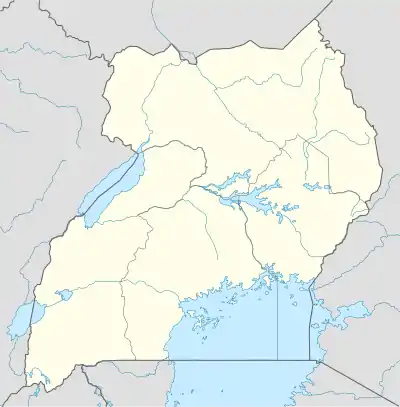Bidi Bidi Refugee Settlement
Bidibidi Refugee Settlement is a refugee camp in northwestern Uganda. With over 270,000 South Sudanese refugees fleeing the ongoing civil war, as of early 2017 it was the largest refugee settlement in the world.[2][1] As of 2018, that distinction was claimed by Kutapalong refugee camp for displaced Rohingya in Bangladesh.[3]

Bidibidi Refugee Settlement | |
|---|---|
 Bidibidi Refugee Settlement | |
| Coordinates: 3.53°N 31.35°E | |
| Country | Uganda |
| District | Yumbe |
| Area | |
| • Total | 250 km2 (100 sq mi) |
Geography
The Bidibidi area covers 250 square kilometres of the eastern half of Yumbe District, stretching southward from the South Sudanese border and spilling over into Moyo District along the western bank of the Kochi River.[4]
History
The Bidibidi area was a small village before becoming a refugee settlement which was opened in August 2016.[5][6] Since then, the Uganda Government and other NGOs have worked to create a settlement rather than a camp to host and contain the influx of the growing number of the asylum seekers from South Sudan.[7]
Social services
Many women in Bidi Bidi refugee settlement have access to psycho-social support and empowerment resources that have been set up within the camp. The U.N. has created a system of revolving funds, meaning that funds are replenished when used, which allows women to learn vocational skills such as hairdressing and helping women build their own businesses. This leads to empowerment and creates a sense of stability in an unstable world of the displaced and worrisome state of the camp.
Caritas International is an organization aimed at promoting justice and helping the poor and they have mobilized efforts to give aid to the people of Bidi Bidi refugee settlement. Depending on which zone of the camp refugees live in, some receive a plot of land, agricultural tools and seeds to begin to sustain themselves and create opportunities for businesses.
ARC - American Red Cross team is responsible for Zone 5 of the camp, providing protection and other support to residents of Bidi Bidi refugee settlement, (it takes 1 hour to drive across Zone 5, alone!). We’re providing post-trauma counseling, working to prevent violence in the camp and helping run the reception center – the place where every refugee first arrives at Bidi Bidi refugee settlement. The Bidi Bidi refugee camp materialized so quickly and many people have come and continued coming, humanitarian groups are still working towards making available all the critical services that are needed by the settlers at this second largest refugee settlement in the world.
Health care
There have been growing concerns about health conditions and access to health services as the number of South Sudan refugees entering Uganda continues to increase, particularly, Bidi Bidi refugee camp, with Reuters reporting that 180 refugees (nearly half of them young children) died in Bidibidi Refugee Settlement in the first six months of 2017.[8] This is compounded by how there is often limited accuracy of health measurements in camp settings, with under-reporting of deaths by humanitarian organizations typically occurring more frequently than over-reporting of deaths.[9]
From a human rights and ethics perspective, there are also questions about whether people with different physical abilities or the elderly are not being prioritized in these settlements, receiving less resources compared to younger, able-bodied residents in good health.[10] In settlements located in the Ayilo District of Northern Uganda, for example, the organization Caritas reports that programs have been designed to provide more assistance for building latrines to groups identified as vulnerable, such as older residents, disabled residents, and child-headed households.[11]
Furthermore, a 2016 U.S. State Department report on trafficking warns that South Sudanese children in Northern Ugandan refugee settlements may be vulnerable to trafficking, with the UNHCR suspecting that instances of trafficking are already occurring among young South Sudanese refugees. Unfortunately, reliably quantifying the number of trafficked children can be a challenge due to lack of effective monitoring, corruption, insufficient protection of victims to come forward, differences in definitions of terms, and other contextual aspects.[12]
References
- Biryabarema, Elias (15 December 2016). "Hatred spills beyond South Sudan along with refugees". Reuters. Retrieved 6 April 2017.
- Hattem, Julian (24 January 2017). "Uganda's sprawling haven for 270,000 of South Sudan's refugees". The Guardian. Retrieved 5 April 2017.
- Altman, M.J. "Rohingya Crisis: A Firsthand Look Into The World's Largest Refugee Camp". World Food Program USA. Archived from the original on 2018-12-11. Retrieved 2018-12-10.
- "Uganda - Bidibidi camp (as of Feb 2017)". reliefweb. Retrieved 6 April 2017.
- "As Thousands Flee South Sudan, Ugandan Refugee Camp Becomes World's Largest". NPR. 5 April 2017.
- "Three months ago, it was a tiny Ugandan village. Now it's the world's fourth-largest refugee camp". The Washington Post. 28 October 2016.
- "In Uganda, a unique urban experiment is under way. The world's second-largest refugee camp is slowly but surely transforming into a permanent city". National Geographic. April 2019.
- Mukasa, Francis. "South Sudanese refugees in Uganda near million mark". U.K. Retrieved 2017-12-04.
- Spiegel, P. B.; Sheik, M.; Woodruff, B. A.; Burnham, G. (June 2001). "The accuracy of mortality reporting in displaced persons camps during the post-emergency phase". Disasters. 25 (2): 172–180. doi:10.1111/1467-7717.00169. ISSN 0361-3666. PMID 11434236.
- Ciottone, Gregory. "Ciottone's Disaster Medicine (Second Edition)".
- "Uganda Refugee Response Monitoring Settlement Fact Sheet: Bidi Bidi (June 2018)".
- Bhabha, Jacqueline (2014). Child Migration and Human Rights in a Global Age. Princeton University Press. ISBN 9780691143606. JSTOR j.ctt5hhrwz.
